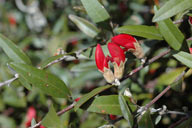In Flower This Week
A weekly news sheet prepared by a Gardens' volunteer.
Numbers before each plant refer to temporary IFTW labels in the gardens.
Numbers in square brackets [ ] refer to garden bed Sections. Plants in flower are in bold type.
View past issues of 'In Flower This Week'.
20 September 2013
Gastrolobium celsianum click for larger image |
This walk is in the Rock Garden. To arrive there follow the road on the far side of the Rainforest Gully, turning right at the junction with the Main Path which will reach the waterfall.
- At the base of the stairs Rhodanthe anthemoides [Sections 15c, 15d and elsewhere] are small plants seen between the rocks, clad with white daisy flowers.
- Grevillea lanigera [Section 15c] is a dense semi-prostrate spreading plant well covered with pink-cream flower clusters.
- The red flower clusters of the Gymea Lily, Doryanthes excelsa [Section 15c], are just opening atop a very long stem, its base surrounded by long sword-like leaves.
- At the top corner of this section is Cotton Bush, Spyridium scortechinii [Section 15c], a semi-prostrate shrub with tiny cream flowers covering nearby rocks.
- Opposite, Grevillea ‘Poorinda Royal Mantle’ [Section 15d] is a dense prostrate plant with developing red toothbrush-like flowers.
- Grevillea monticola [Section 15d] is well covered with cream, short toothbrush-like flower spikes.
- Buttercups, Ranunculus collinus, [Section 15b], with their shiny yellow flowers edge part of this garden.
- The pot nearby contains a wattle, Acacia pterocaulon [Section 15e], with long almost flattened branches covered with bright yellow flower balls. It shares the pot with Hovea asperifolia, a small shrub with purple pea-shaped flowers.
- Rulingia luteiflora [Section 15f] is a medium‑sized shrub, with small yellow dark‑centred flowers.
- In front Acacia pravissima ‘Kuranga Cascade’ [Section 15h], clad with its lovely yellow flower balls, falls over the rock face.
- Bulbine glauca [Section 15a] is a succulent plant bearing yellow star-like flowers on upright stems surrounded by linear leaves.
- Edging the stairs, Homoranthus flavescens [Section 15a] are medium-sized flat-topped shrubs with yellowish flattened buds.
- From the top road Grevillea iaspicula [Section 15h], a local plant, can be seen. It is medium-sized with pale pink-cream flower clusters.
- Hibbertia empetrifolia [Section 15h] has dense trailing stems, now bright with its yellow flowers.
- A Philotheca sp. [Section 15j] is profuse with a covering of white multi-petalled flowers over the medium-sized shrub.
- Follow the path down to the next level to view a waratah, Telopea speciosissima ‘Wirrimbirra White’ [Section 15r] a tall dense shrub with large cream flower buds which will mature to the remarkable off-white flowers.
- Next is Alyogyne huegelii [Section 15r], which displays its large purple hibiscus flowers.
- An Emu-bush, Eremophila alternifolia [Section 15r], is of medium size and displays its red-shaded bugle-shaped flowers.
- Philotheca verrucosa ‘J. Semmens’ [Section 15r] is a low open shrub with rare multi-layered white-petalled flowers.
- Edging the lower right Main Path is Swan River Pea, Gastrolobium celsianum [Section 15r], a dense prostrate plant with many curved red flowers.
- Indigofera australis [Section 4], a local plant, is upright and clad with many pink pea‑shaped flowers edging its arching branches.
- A Thomasia sp. [Section 4] is so bright with its many deep pink flowers over the medium‑sized plant.
Plants never seem to stop flowering now that spring is here...
Barbara Daly
![Director of National Parks [logo]](../../../../images/dnp_90px.gif)







